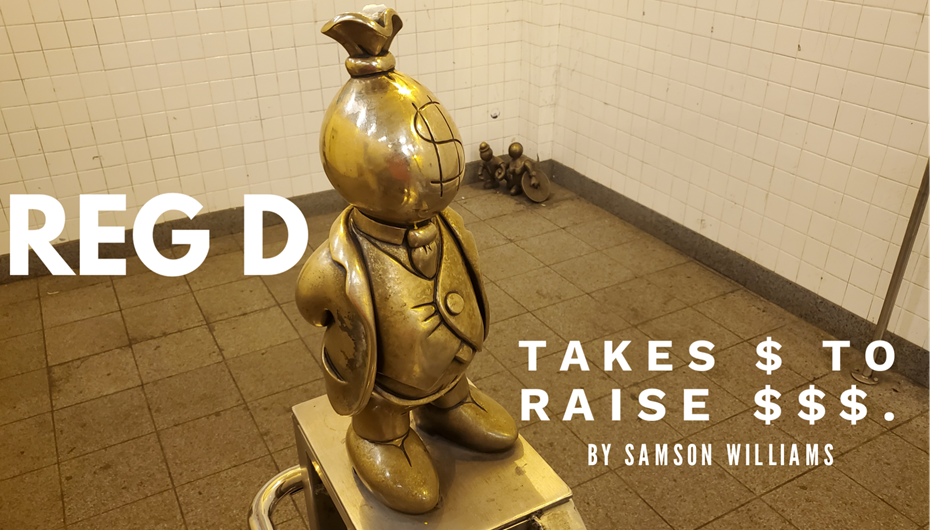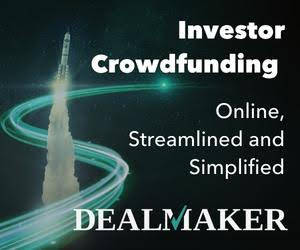A bit ago I was on a webinar for Financial Poise, where I said that startups can expect to have a sunk cost of ~$46k in travel expenses alone and expect to take on average 21 months to raise money using the Reg D exception. On the webinar was “Mark”, the archetypical securities lawyer, who in typical lawyer fashion disagreed vehemently with these figures. So, what follows is a simple breakdown of typical expenses incurred in raising money via not only via Reg D but also JOBS ACT Reg CF and Reg A/A+ crowdfunding. Because it turns out that it still takes money to make money.
The Sunk Costs of Raising Capital
“A sunk cost is a cost that has already been incurred and cannot be recovered.”
There are numerous sunk costs in raising capital. For the entrepreneurs out there who will actually cut the checks here are the cold hard facts.
Reg D
Raising money via Reg D is the easiest and cheapest way to raise money if:
- You have an established business that is currently generating profit;
- Your business has revenues and operations which could be streamlined to be more efficient and,
- You know an existing network of accredited investors who are not only interested in investing but also interested in investing in your particular business, and,
- Who will also agree to terms that both parties will accept
Basically, if you have a rich uncle, friends and family and/or network raising money for your business then using Reg D is the easiest way to raise money. There is little to no marketing involved and most deals are concluded over lunch or in small meetings. The paperwork for accepting funds from 3-10 investors is minimal and typically consist only of a Private Placement Memorandum (PPM). If you meet the four criteria above, and you already have a lawyer/law firm that you work with for other business matters, then they’d be happy to bill between $10k - $20k just for the PPM. With a PPM you can raise unlimited amounts of money from your accredited investor friends, family and network with very little sunk cost associated with the raise. For instance, if you have a cash flow positive business (or want to do a real estate deal), then a $15k PPM for a $100M deal is cheap. Your existing law firm is happy to draft that for you, as they value you as a long-time client and know that there will be more business coming down the line once you secure that $100M deal. Ultimately, Mark is correct. Raising money via Reg D is very inexpensive and hassle-free if you already have a monied network. However, for startups, who are non-monied individuals, the ease of ACCESSING networks, to ATTEMPT to raise funds, comes with costs.
Who The F* Are You?
Old money does not invest in startups. They invest in funds that invest in startups. Old money doesn’t talk to entrepreneurs. Old money golfs with their financial advisors and bankers, who may, as less than a percent of their overall portfolio, advise them to invest in a fund that invests in startups. Why? Investing in startups is risky business and they don’t know who the f* you are.
As humans, we naturally distrust strangers. If I don’t know you, I’ve no reason to form an opinion to like you. If a person doesn’t know you and like you, the odds of them trusting you are about zero. If you are known and liked, the odds of them trusting you with their money to invest in you, is slightly greater than zero, but not more than 0.91% for angel investments and 0.05% or VC and even those numbers come with an asterisk. You can check out recent data points here from 2018.
Generally speaking, if investors don’t know who the F* you are (or that you even exist) getting investments requires sunk cost to be invested, in getting known. Aka marketing yourself. So, when Angels, VC, and accredited investors don’t know you or your product and you may or may not have a product or revenue (that’s one of those odd things about being a “startup”, occasionally you’re not an established business) you have a few hurdles to overcome, including but not limited to:
- Getting known by accredited investors
- Finding said accredited investors
- Getting introduced to those investors so they can learn about your good, product or service
- Overcoming the “stranger danger” of being a risky entrepreneur/startup, who they don’t know
- Hoping your startup aligns to their investment ethos/portfolio goals
- Convincing them to actually invest in your startup
- Actually agreeing with them on the terms of their investment. “Not all money is good money”, Pamela Norris, CEO of Ice Buddy Systems, Inc on why she recently turned down a $3M investment.
Accomplishing those 7 factors have sunk cost that average ~$46k just in travel expenses alone (airfare, bus, (yes many a Founder takes the bus to and from conferences and meetings) hotel/uber, etc…) and take ~21 months. However, these figures come with asterisks as well. Because of all of the startup founders interviewed and data collected, we were only able to collect information from those who actually got funding. Remember how less than 1% of startups are successful at getting funding? So the error rate on the $46k/21 months is +/- 99%. Turns out, it is hard to get smart, savvy, educated people who have blown their life savings and are now bankrupt trying to grow a startup to be willing to relive the horror of watching their best-laid calculations and planning implode into soul-crushing debt, divorce and anxiety. If you didn’t already know this, being an entrepreneur isn’t for everyone. Here is a two minute video by Sramana Mitra, Founder of One Million By One Million, one of the best entrepreneur blogs you’ve never heard of that provides more insights into the realities of getting funding. Highly recommend you check her out and watch her LinkedIn vlogs.
What You Sink Your Money Into
It takes money to make money. Here are some of the common expenses of seeking funding:
- Pitch deck ($5k)
- 80+ hours to create/edit/refine, typically with a team of 4-7 people
- Graphic designer to make it look pretty
- Lawyer to review the content/copy
- Quality print job at Kinkos (heavier paper, full color, binding, and formatting can easily run you $30 per deck (assuming no more than 20 pages) in printing cost alone)
- Each meeting you’ll take at least 3 decks. One for you. One for the investor and one for their team members. You may take as many as 5 - 7 decks to a meeting depending on who you’re meeting with. Rather, think of it as you’re taking $90 to $210 dollars of paper to each meeting that you’ll never see again.
- Pitch Deck Summary - it is very easy to sink $5k into a pitch deck and not even realize it
- Pitch video ($1 to $20k)
- At a minimum, you need a 30-60 second pitch video. Ideally, you have a professionally made 30 second, 60 second, 3-minute and 5-minute video
- Each can cost as much individually as you’d like to spend
- If you’re a whiz with your cell phone it can be as cheap as your time. If you’re not, plan on paying a professional
- Airfare to NYC or San Francisco ($300.00 one way, $800 for “last minute” trips)
- Uber/Taxi from airport to hotel ($75 dollars each way)
- 3 nights hotel ($600). You won’t fly in the morning of and fly out the same night until you’ve done your first 20 pitches. So, you’re gonna stay minimum 2 nights (the night before and the night of), more likely 3 nights, as you’ll try to arrange other meetings while you’re there. Oh, and you lose 5 days of productivity/work income, while you’re busy jet setting, begging for millions in a suit. But we’ll ignore that opportunity cost and focus just on the real travel costs.
- Food. $50 a day minimum. $10 breakfast, $20 lunch, $20 dinner, which trust me in any major city in the USA/Globe isn’t fancy eating at all. Expect to either lose 30lbs from the stress or gain 30lbs from the stress/poor eating habits. There is an emotional and physical toll of raising capital but for the purpose of this article, we’re just focusing on the travel expenses.
- Angel / VC dinners. Here is a fantastic way to blow $200 - $400 on a meal. Because you’ve often got to tow the fine line between trying to impress the person and picking restaurant they’d be willing to eat at. After all, they know 99% of the time they’re not going to be interested in your deal, so are generally just looking forward to the meal.
- Anticipate a minimum of 50 meetings to get an investment. Remember, not all money is good money. The majority of your initial offers will be so predatory and/or from dubious sources (I’ll tell you a great story about how the Mob/Triads invest in early stage startups over a beer one day) that you’ll not want to have anything to do with those “investors”.
- If you’re a woman, double the number of meetings (and cost) and you’re still probably more likely to get struck by lightning, in a basement, on a sunny day than securing Angel or VC investment. The reasoning for this is super simple. You have a vagina and are being taxed for it. #vaginatax. I tease. Women get an astounding 2.2% of VC funding, despite women-led businesses being 35% more profitable than men led businesses. Chances are that when women-led businesses are 70% more profitable than men led businesses they’ll probably break the 5% mark of funding.
In the above scenario of 50 VC meetings, your sunk cost is $69,500.00; not including your video and printing cost. It's always advisable to try and schedule 2-4 meetings per trip/flight; to reduce the total number of trips. If you can cut it down to 25 trips (over a 21 month period) then you only have to be out begging for money in a suit about once a month. And “NO”, a big “NO”. Living in San Francisco or NYC does not save you money in accessing capital. Yes, you won’t have to plan or take nearly as many trips. However, do you know how much it costs to live in NYC or SF and build a startup?
Last but not least, the above scenario only involved one Founder. If you take your team to help you pitch with/to investors multiply the sunk cost by however number of team members you take. Yes, you can double up on hotels but airfare is airfare and even interns and COOs need to eat.
Conclusion
- It still takes money to make money.
- If you have an existing business, with revenue and an investor network, who would be interested AND willing to invest in your business, Reg D is the “easiest” option.
- Otherwise, it still takes money to make money...particularly if you’re also paying a #vaginatax.
For JOBS Act Reg CF, for raising up to $5M you should anticipate sunk cost of at least $25k and up to $150k+ to execute a successful raise. For Reg A / Reg A+, you should anticipate a minimum of $150k up to $500k+ to attempt to raise up to $50M. Reg A / Reg A+ is designed specifically for people who don’t know a network of accredited investors but need to raise more than $5M; typically in the $7M - $15M dollar range. Note - In July 2019, Blockstack incurred $2M in legal fees registering their “securitized token offering” (aka, STO) for a $28M, RegA raise. This is not “normal”. However, Blockstack paid the price of going first and benefited from the buzz. So keep in mind that a RegA/RegA+ may be as little as $150k or as much as $2M depending on your projects unique circumstances. In all instances, get proper legal advice and don’t be afraid to invest in marketing.
Last but not least. Crowdfunding may not be your best option. All fundraising comes with risk and is a great way to lose all your money. Be sure to write down your cost and gain an understanding of what you’re really about to do. If you’re in doubt, don’t hesitate to reach out to me. As I’ve paid the iron-price to learn what it takes to fund and run a business, so you don’t have to. Cheers and may the odds and the algorithms forever be in your favor.
Samson
Register for FREE to comment or continue reading this article. Already registered? Login here.
2



Nice work.
I just want to add this - Don't spend ALL your money on Fundraising.
He's telling you it can cost up to 69k. So don't raise 69k telling investors you're going to use it to raise a few million.
We tried that. It did not work. It cost us years of our lives operating at less than peak performance.
The gory details -
Our company raised 50k angel capital in May of 2017 a couple months after incorporating in March. I pitched 1 individual. Closed 1 deal.
We then spent that money in an attempt to raise a larger sum, doing things such as suggested in this post like creating a pitch deck, developing a buyer list, making intros to angels and VCs, getting validation from prospects. In the end we failed to raise very much additional capital, ran out of runway, and still didn't have a product. So we had to raise again. The 2nd time, it was more difficult.
My iron-price lesson to you is that if you are a business that has an idea and you know a market exists for that idea, invest early capital in building the product, acquiring customers, getting feedback from those customers. Rinse and repeat.
Betting on the possibility of success in fundraising at Pre-Seed without a network advantage or a venture connection that deviates from the norm will just mean splitting your efforts between your business and your pitching of the business. The costs are dilution and potentially, your relationships.
This is only one person's POV, but if I could go back and spend that initial 50k we raised differently, I would, and I'd spend it all on building the product. We had a quote for 50k for an MVP build. Then we struggled like hell to get back to 50k because the capital came in chunks of 25k every couple months from people making their 1st or 2nd private placements. Business expenses added up. It was a war of attrition and no one was winning. When we finally got the capital to spend on development, our developer had moved forward in their life-plan and was having children, then the Coronavirus hit and they couldn't find a sitter. Delay upon delay that we had no control over. We eventually got to market, but experienced a cold start problem once we got there. When I get down, I read about Saguaros.
Don't give up.
Don't make the same mistake.
Don't spend ALL your money on Fundraising.
Thanks for Sharing Samson.
Dagan
You've paid the iron price indeed. Thanks for sharing this leg of your journey. Please keep sharing. Others need to know that success often looks more like a hurricane track, not a straight line.